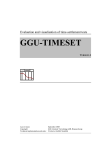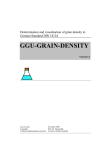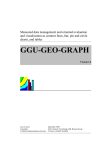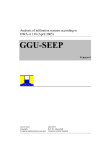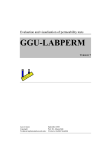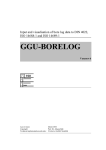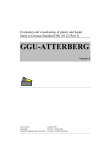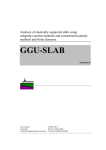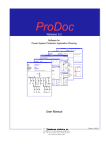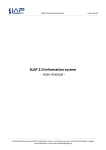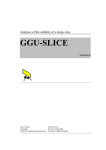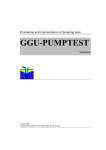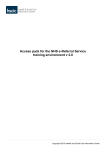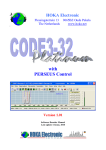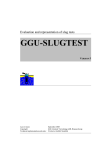Download GGU-LIME - Index of
Transcript
Determination and visualisation of lime content
to DIN 18129
GGU-LIME
VERSION 5
Last revision:
September 2008
Copyright:
GGU Zentrale Verwaltung mbH, Braunschweig
Technical implementation and sales: Civilserve GmbH, Steinfeld
Contents:
1 Preface .................................................................................................................................. 4
2 Licence protection and installation .................................................................................... 4
3 Language selection............................................................................................................... 5
4 Starting the program ........................................................................................................... 5
5 Description of menu items................................................................................................... 6
5.1 File menu.......................................................................................................................... 6
5.1.1 "New" menu item..................................................................................................... 6
5.1.2 "Load" menu item .................................................................................................... 6
1.1.1 "Save" menu item .................................................................................................... 6
5.1.3 "Save as" menu item ................................................................................................ 6
5.1.4 "Printer preferences" menu item .............................................................................. 6
5.1.5 "Print and export" menu item .................................................................................. 7
5.1.6 "Batch print" menu item .......................................................................................... 9
5.1.7 "Exit" menu item...................................................................................................... 9
5.1.8 "1, 2, 3, 4" menu items............................................................................................. 9
5.2 Edit menu ....................................................................................................................... 10
5.2.1 "Preferences" menu item........................................................................................ 10
5.2.2 "Tests" menu item.................................................................................................. 10
5.2.3 "Delete all tests" menu item................................................................................... 11
5.2.4 "General" menu item.............................................................................................. 12
5.2.5 "Company" menu item........................................................................................... 12
5.3 Graphics preferences menu ............................................................................................ 13
5.3.1 "Refresh and zoom" menu item ............................................................................. 13
5.3.2 "Zoom info" menu item ......................................................................................... 13
5.3.3 "Legend font selection" menu item........................................................................ 13
5.3.4 "Font size selection" menu item............................................................................. 13
5.3.5 "Mini-CAD toolbar" menu item ............................................................................ 13
5.3.6 "Toolbar preferences" menu item .......................................................................... 14
5.3.7 "Load graphics preferences" menu item ................................................................ 14
5.3.8 "Save graphics preferences" menu item................................................................. 14
5.4 Output preferences menu ............................................................................................... 15
5.4.1 "Page size" menu item ........................................................................................... 15
5.4.2 "Texts" menu item ................................................................................................. 15
5.4.3 "Table texts + allocations" menu item ................................................................... 16
5.4.4 "Margins" menu item............................................................................................. 17
5.4.5 "Position info" menu item...................................................................................... 17
5.4.6 "Title (change position)" menu item...................................................................... 17
5.4.7 "Company" menu item........................................................................................... 18
5.4.8 "Test no., etc." menu item...................................................................................... 18
5.4.9 "Annex and report" menu item .............................................................................. 18
5.4.10 "Table" menu item ................................................................................................. 19
5.4.11 "Reset all" menu item ............................................................................................ 19
5.4.12 "Move objects" menu item..................................................................................... 20
GGU-LIME User Manual
Page 2 of 24
September 2008
5.5 ? menu ............................................................................................................................ 21
5.5.1 "Copyright" menu item .......................................................................................... 21
5.5.2 "Maxima" menu item ............................................................................................. 21
5.5.3 "Help" menu item .................................................................................................. 21
5.5.4 "GGU on the web" menu item ............................................................................... 21
5.5.5 "GGU support" menu item..................................................................................... 21
5.5.6 "What's new?" menu item...................................................................................... 21
5.5.7 "Language preferences" menu item ....................................................................... 21
6 Tips...................................................................................................................................... 22
7 Index.................................................................................................................................... 23
GGU-LIME User Manual
Page 3 of 24
September 2008
1 Preface
The GGU-LIME program allows evaluation and visualisation of lime content to DIN 18129.
The program is designed to allow simple data input. The system is permanently displayed on the
screen. Every alteration to the data is shown on the screen, so that optimum control of input data is
guaranteed. Graphic output supports the true-type fonts supplied with WINDOWS, so that
excellent layout is guaranteed. Colour output and any graphics (e.g. files in formats BMP, JPG,
PSP, TIF, etc.) are supported. DXF files can also be imported by means of the integrated MiniCAD module (see the "Mini-CAD" manual).
The program has been thoroughly tested on numerous examples from the literature and in
engineering practice. No faults have been found. Nevertheless, liability for completeness and
correctness of the program and the manual, and for any damage resulting from incompleteness or
incorrectness, cannot be accepted.
2 Licence protection and installation
In order to guarantee a high degree of quality, a hardware-based copy protection system is used
for the GGU-LIME program.
The GGU software protected by the CodeMeter copy protection system is only available in
conjunction with the CodeMeter stick copy protection component (hardware for connection to the
PC, "CM stick"). Because of the way the system is configured, the protected software can only be
operated with the corresponding CM stick. This creates a fixed link between the software licence
and the CM stick copy protection hardware; the licence as such is thus represented by the CM
stick. The correct Runtime Kit for the CodeMeter stick must be installed on your PC.
Upon start-up and during running, the GGU-LIME program checks that a CM stick is connected.
If it has been removed, the program can no longer be executed.
For installation of GGU software and the CodeMeter software please refer to the information in
the Installation notes for GGU Software International, which are supplied with the program.
GGU-LIME User Manual
Page 4 of 24
September 2008
3 Language selection
GGU-LIME is a bilingual program. The program always starts with the language setting applicable when it was last ended.
The language preferences can be changed at any time in the "?" menu, using the menu item
"Spracheinstellung" (for German) or "Language preferences" (for English).
4 Starting the program
After starting the program, you will see two menus at the top of the window:
• File
• ?
By going to the "File" menu, a previously saved file can be loaded by means of the "Load" menu
item, or a new one created using "New". After clicking on "File/New" an empty form in accordance with German Standard DIN 18129 is shown on the screen. Five menus now appear at the
top of the window:
• File
• Edit
• Graphics preferences
• Output preferences
• ?
After clicking one of these menus, the so-called menu items roll down, allowing you access to all
program functions.
The program works on the principle of What you see is what you get. This means that the screen
presentation represents, overall, what you will see on your printer. In the last consequence, this
would mean that the screen presentation would have to be refreshed after every alteration you
make. For reasons of efficiency and as this can take several seconds for complex screen contents,
the GGU-LIME screen is not refreshed after every alteration.
If you would like to refresh the screen contents, press either [F2] or [Esc]. The [Esc] key additionally sets the screen presentation back to your current zoom, which has the default value 1.0, corresponding to an A4 format sheet.
GGU-LIME User Manual
Page 5 of 24
September 2008
5 Description of menu items
5.1
5.1.1
File menu
"New" menu item
All data entered will be deleted after a confirmation prompt. You can then define new tests.
5.1.2
"Load" menu item
You can load a file with test data, which was created and saved at a previous sitting, and then edit
the test data.
1.1.1
"Save" menu item
You can save data entered or edited during program use to a file, in order to have them available at
a later date, or to archive them. The data is saved without prompting with the name of the current
file.
5.1.3
"Save as" menu item
You can save data entered during program use to an existing file or to a new file, i.e. using a new
file name. For reasons of clarity, it makes sense to use ".klk" as file suffix, as this is the suffix
used in the file requester box for the menu item "File/Load". If you choose not to enter an extension when saving, ".klk" will be used automatically.
5.1.4
"Printer preferences" menu item
You can edit printer preferences (e.g. swap between portrait and landscape) or change the printer
in accordance with WINDOWS conventions.
GGU-LIME User Manual
Page 6 of 24
September 2008
5.1.5
"Print and export" menu item
You can select your output format in a dialogue box. You have the following possibilities:
• "Printer"
allows graphic output of the current screen to the WINDOWS standard printer or to any
other printer selected using the menu item "File/Printer preferences". But you may also
select a different printer in the following dialogue box by pressing the "Printer
prefs./change printer" button.
In the upper group box, the maximum dimensions which the printer can accept are given.
Below this, the dimensions of the image to be printed are given. If the image is larger than
the output format of the printer, the image will be printed to several pages (in the above example, 4). In order to facilitate better re-connection of the images, the possibility of entering an overlap for each page, in x and y direction, is given. Alternatively, you also have
the possibility of selecting a smaller zoom factor, ensuring output to one page ("Fit to page" button). Following this, you can enlarge to the original format on a copying machine,
to ensure true scaling. Furthermore, you may enter the number of copies to be printed..
• "DXF file"
allows output of the graphics to a DXF file. DXF is a common file format for transferring
graphics between a variety of applications.
GGU-LIME User Manual
Page 7 of 24
September 2008
• "GGUCAD file"
allows output of the graphics to a file, in order to enable further processing with the
GGUCAD program. Compared to output as a DXF file this has the advantage that no loss
of colour quality occurs during export.
• "Clipboard"
The graphics are copied to the WINDOWS clipboard. From there, they can be imported
into other WINDOWS programs for further processing, e.g. into a word processor. In order
to import into any other WINDOWS program you must generally use the "Edit/Paste"
function of the respective application.
• "Metafile"
allows output of the graphics to a file in order to be further processed with third party software. Output is in the standardised EMF format (Enhanced Metafile format). Use of the
Metafile format guarantees the best possible quality when transferring graphics.
If you select the "Copy/print area" tool
from the toolbar, you can copy parts of
the graphics to the clipboard or save them to an EMF file. Alternatively you can send
the marked area directly to your printer.
Using the "Mini-CAD" program module you can also import EMF files generated using other GGU applications into your graphics.
• "MiniCAD"
allows export of the graphics to a file in order to enable importing to different GGU applications with the Mini-CAD module.
• "GGUMiniCAD"
allows export of the graphics to a file in order to enable processing in the GGUMiniCAD
program.
• "Cancel"
Printing is cancelled.
GGU-LIME User Manual
Page 8 of 24
September 2008
5.1.6
"Batch print" menu item
If you would like to print several appendices at once, select this menu item. You will see the following dialogue box:
Create a list of files for printing using "Add" and selecting the desired files. The number of files is
displayed in the dialogue box header. Using "Delete" you can mark and delete selected individual
files from the list. After selecting the "Delete all" button, you can compile a new list. Selection of
the desired printer and printer preferences is achieved by pressing the "Printer" button.
You then start printing by using the "Print" button. In the dialogue box which then appears you
can select further preferences for printer output such as, e.g., the number of copies. These preferences will be applied to all files in the list.
5.1.7
"Exit" menu item
After a confirmation prompt, you can quit the program.
5.1.8
"1, 2, 3, 4" menu items
The "1, 2, 3, 4" menu items show the last four files worked on. By selecting one of these menu
items the listed file will be loaded. If you have saved files in any other folder than the program
folder, you can save yourself the occasionally onerous rummaging through various sub-folders.
GGU-LIME User Manual
Page 9 of 24
September 2008
5.2
5.2.1
Edit menu
"Preferences" menu item
It is possible to specify settings for the results table to suit user requirements.
Specify whether the computed lime content should be given in per cent (e.g. 10.5%) or as an absolute value (e.g. 0.105) by activating the check box. Please note that if the settings are changed the
texts in the results table must also be adapted accordingly (see Section 0).
The number of columns (maximum 6) and the number of tables (maximum 4) can be specified
using the two drop-down list boxes in the dialogue box. Further changes to the table visualisation
are possible using the menu item "Output preferences/Table" (see Section 5.4.7).
5.2.2
"Tests" menu item
This represents the program's central menu item. All the basic data involved in the determination
of lime content is entered here. After clicking this menu item or double-clicking in the result table
the following dialogue box opens (example):
Three tests are already present in this example. The tests are automatically numbered and the test
numbers ("1, 2, 3, ...") shown on the respective buttons. The following actions are possible:
• "To menu bar"
You return to the original menu bar.
• "New"
You can now enter data for a new test.
• "1", "2", ...
By clicking the buttons labelled with the test numbers you can open and edit the data for
the corresponding test.
GGU-LIME User Manual
Page 10 of 24
September 2008
After clicking on "New" or on the button of an existing test a dialogue box opens for entering or
editing test data. Remember that DIN 18129 uses [kPa] as the unit of air pressure.
Enter the obligatory data in the input boxes shown in the dialogue box to determine the lime content. Further input boxes for entering additional information can be defined using the menu item
"Output preferences/Table texts + allocations" (see Section 0). The following actions are also
possible from the above dialogue box:
• "Delete test"
The currently displayed test will be deleted.
• "Duplicate test"
The currently displayed test will be duplicated. You will automatically find yourself in the
next test. All the values used in the old test are transferred to the new one.
• "Show data"
The input data and test results corresponding to any entered single tests are displayed in a
message box. The data are subsequently display in the results table on the output sheet.
• "Done"
You will arrive back at the previous dialogue box. All values entered will be accepted.
5.2.3
"Delete all tests" menu item
After a security request, all tests will be deleted. After this, you can enter a new test using the
"Edit/Tests" menu item (see Section 5.2.2).
GGU-LIME User Manual
Page 11 of 24
September 2008
5.2.4
"General" menu item
Go to this menu item to enter general data such as the project identification, report number, annex
number, etc. This data is displayed in the correct elements of the output sheet.
The marked texts in the dialogue box also appear in the output sheet. Input boxes can be altered or
switched off such as "Test number:" as shown in the above dialogue box by going to the menu
item "Output preferences/Texts" (see Section 5.4.1).
5.2.5
"Company" menu item
You can enter your company address in four lines. These lines will be entered at the top left of the
form.
GGU-LIME User Manual
Page 12 of 24
September 2008
5.3
5.3.1
Graphics preferences menu
"Refresh and zoom" menu item
The program works on the principle of What you see is what you get. This means that the screen
presentation represents, overall, what you will see on your printer. In the last consequence, this
would mean that the screen presentation would have to be refreshed after every alteration you
make. For reasons of efficiency and as this can take several seconds for complex screen contents,
the screen is not refreshed after every alteration.
If, e.g., after using the zoom function (see below), only part of the image is visible, you can achieve a complete view using this menu item.
A zoom factor between 0.4 and 8.0 can be entered in the input box. By then clicking on "Use" to
exit the box the current factor is accepted. By clicking on the "0.4", "0.6", etc. buttons, the selected factor is used directly and the dialogue box closed.
It is much simpler, however, to get a complete overview using [Esc]. Pressing [Esc] allows a complete screen presentation using the zoom factor specified in this menu item. The [F2] key allows
screen refreshing without altering the coordinates and zoom factor.
5.3.2
"Zoom info" menu item
By clicking two diametrically opposed points you can enlarge a section of the screen in order to
view details better. An information box provides information on activating the zoom function and
on available options.
5.3.3
"Legend font selection" menu item
With this menu item you can switch to a different true-type font. All available true-type fonts are
displayed in the dialogue box.
5.3.4
"Font size selection" menu item
You can edit font sizes of texts [in mm] within the various input areas.
5.3.5
"Mini-CAD toolbar" menu item
Using this menu item you can add free text to the graphics and add lines, circles, polygons and
images (e.g. files in formats BMP, JPG, PSP, TIF, etc.). A pop-up menu opens; the icons and
functions used are described in more detail in the "Mini-CAD" manual provided.
GGU-LIME User Manual
Page 13 of 24
September 2008
5.3.6
"Toolbar preferences" menu item
After starting the program a horizontal toolbar appears below the program menu bar. If you would
rather work with a popup window with several columns, you can specify your preferences using
this menu item. The smarticons can also be switched off.
At the bottom of the program window you find a status bar with further information. You can also
activate or switch off the status bar here. The preferences will be saved in the "GGU-LIME.alg"
file (see menu item "Graphics preferences/Save graphics preferences") and will be active at the
next time the program is started.
By clicking on the tools (smarticons) you can directly reach most of the program functions. The
meaning of the Smarticons appears as a text box if you hover with the mouse pointer over the
tools. Some of the tool functions can be activated from the normal menu items.
"Zoom out"
If you have previously zoomed in, this tool returns to a full screen display.
"Zoom (-)" / "Zoom (+)"
With the zoom functions you can zoom in or out of parts of the image, by clicking the left mouse
button.
"Undo move object"
If you have previously edited the position or size of an element on the output sheet ([F11] or used
"Output preferences/Move objects"), you can undo the last changement with this tool.
"Restore move object"
If you have previously undone a changement, you can restore with this tool.
"Copy/print area"
Use this tool to copy only parts of the graphics in order to paste them, e.g. to a report. You will see
information on this function and can then mark an area, which is copied to the clipboard or can be
saved in a file. Alternatively you can send the marked area directly to your printer.
5.3.7
"Load graphics preferences" menu item
You can reload a graphics preferences file into the program, which was saved using the "Graphics preferences/Save graphics preferences" menu item. Only the corresponding data will be
refreshed.
5.3.8
"Save graphics preferences" menu item
Some of the preferences you made with the menu items of the "Graphics preferences" menu as
well as the inputs using the "Edit/Company" menu item can be saved to a file. If you select
"GGU-LIME.alg" as file name, and save the file on the same level as the program, the data will
be automatically loaded the next time the program is started and need not be entered again.
GGU-LIME User Manual
Page 14 of 24
September 2008
5.4
5.4.1
Output preferences menu
"Page size" menu item
The default page set-up is A4 (portrait) when the program is started. You can edit the page size in
the dialogue box.
5.4.2
"Texts" menu item
The default labelling of some output sheet elements can be edited in this menu item's dialogue
box. Among other things, the name of the output sheet can be specified here.
Your input in lines 1 to 6 of the above dialogue box, as well as the input for "Report:" and "Annex:" also represent the designations for the input boxes in the "Edit/General" menu item dialogue
box. If lines are deactivated in the above dialogue box, the corresponding input boxes in the "Edit/General" menu item dialogue box are also deactivated (see Section 5.2.4). Use "Reset" to
restore the default labelling settings.
GGU-LIME User Manual
Page 15 of 24
September 2008
5.4.3
"Table texts + allocations" menu item
A dialogue box opens for specifying the parameters and properties to be displayed in the result
table. It is possible to display up to a maximum of 14 lines. The sequence corresponds to the numbering in the following dialogue box:
Enter texts by hand in the "Heading" boxes, which are later used as a label. After clicking the
arrows in the "Enter what?" column the data or text in the drop-down list entered by hand or
determined by the program can be allocated to the to the rows of the results table. Lines with a
"None" allocation are not displayed.
If information that is not found in the table default texts needs to be added to the results table a
"Free text" can be used. This row then appears in the test data input box with the user-defined
labelling (see Section 5.2.2).
The "Reset" button resets the labelling and allocations of the results table to the defaults. Depending on whether lime content visualisation is selected in per cent or not in the "Edit/Preferences"
menu item (see Section 5.2.1), rows 7 to 10 are labelled in [%] or dimensionless. The "Means
info" button opens a message box with a description of the "Mean value" row.
GGU-LIME User Manual
Page 16 of 24
September 2008
5.4.4
"Margins" menu item
In the default program preferences the form is shown with cutting borders. For output to an A4
printer, a reduction of the printer output is generally necessary, as proprietary printers cannot fully
cover an A4 page. The margin preferences can be defined in the following dialogue box.
By deactivating the "With borders" check box and with an appropriate choice of left and lower
margins, it is generally possible to create a non-reduced printer output. It is necessary to also adapt
the page height and width (see Section 5.4.1).
5.4.5
"Position info" menu item
The positions and layout of the individual elements on the output sheet can be altered using the
following menu items. This menu item provides information on the options for altering the position and layout more quickly using the mouse.
5.4.6
"Title (change position)" menu item
The position and layout of the title element can be altered via the dialogue box for this menu item,
if the "Title display" check box is activated.
The position of the element on the output sheet and its size can be defined or edited by means of
the variables "x" and "y", "dx" and "dy". The element can be provided with a frame and a background colour to suit your personal requirements. If the element needs to be returned to its original
condition, this can be done using the "Reset" button. Alternatively, you can alter the size and
shape of the element using the mouse (see menu item "Output preferences/Move objects", Section Fehler! Verweisquelle konnte nicht gefunden werden.).
GGU-LIME User Manual
Page 17 of 24
September 2008
The heading "Lime content" shown in the title element can be edited in the menu item "Output
preferences/Texts" (see Section Fehler! Verweisquelle konnte nicht gefunden werden.). The
texts "Project (1st line)" and "Project (2nd line)" are entered immediately after double-clicking the
element or using the menu item "Edit/General" (see Section 5.2.4).
5.4.7
"Company" menu item
Almost exactly the same dialogue box opens with the same preference options as that described in
the "Output preferences/Title (change position)" menu item (see Section 5.4.6). Simply proceed
as described there to edit the "Company" element.
The input for this element can be edited immediately after double-clicking on the element or via
the menu item "Edit/Company" (see Section 5.2.5).
5.4.8
"Test no., etc." menu item
Almost exactly the same dialogue box opens with the same preference options as that described in
the "Output preferences/Title (change position)" menu item (see Section 5.4.6). To edit the
"Test no., etc." element, simply proceed as described there.
The input for this element can be edited immediately after double-clicking on the element or via
the menu item "Edit/General" (see Section 5.2.4). For this element you also have the option of
adapting the texts in front of the input boxes to suit your needs. Go to the menu item "Output
preferences/Texts" (see Section 5.4.2).
5.4.9
"Annex and report" menu item
Almost exactly the same dialogue box opens with the same preference options as that described in
the "Output preferences/Title (change position)" menu item (see Section 5.4.6). To edit the
"Annex and report" element, simply proceed as described there.
The input for this element can be edited immediately after double-clicking on the element or via
the menu item "Edit/General" (see Section 5.2.4). For this element you also have the option of
adapting the texts in front of the input boxes to suit your needs. Go to the menu item "Output
preferences/Texts" (see Section 5.4.2).
GGU-LIME User Manual
Page 18 of 24
September 2008
5.4.10
"Table" menu item
Using this menu item, not only the size and position of the table elements can be varied, but also
the structure of the results table: The number of columns to be included in the table can be specified in the dialogue box, together with the number of any tables to be created. The overall size of
the table is given by "dx" and "dy".
The width of the left table column with the labelling is specified in the "Text field width" input
box. The width is given in [mm], the labelling font size is automatically adjusted to the available
space. The number of tests (= columns) to be visualised in a results table can be specified using
the "No. of columns" drop-down list box. The columns are divided equally across the remaining
table width, the font size of the column headings is also adapted to the available space. The font
size of the test data entered can be edited using the "Graphics preferences/Font size selection"
menu item (see Section 5.3.4).
The number of rows in a results table and the labelling of the first row can be adapted to suit userrequirements using the menu item "Output preferences/Table texts + allocations" (see Section 5.4.3).
5.4.11
"Reset all" menu item
With this button, all preferences for the aforementioned elements, which may have been edited
with the previous menu item, will be reset to the program defaults.
GGU-LIME User Manual
Page 19 of 24
September 2008
5.4.12
"Move objects" menu item
When you go to this item you can move the various objects with the aid of the mouse. Move the
mouse over the object to be moved. When you are located above a moveable object the mouse
pointer appears in the shape of a cross. You can now press and hold the left mouse button and
drag the object to the required position.
After going to this menu item only one object at a time can be moved using the mouse or
its size be altered.
In order to move or edit several objects, this function can be more quickly activated by
pressing [F11] or the
icon.
The size of an object can also be altered using this menu item or the [F11] key. If you move over
the frame of a changeable object after activating this function the mouse assumed the shape of a
double-headed arrow. Hold the left mouse button and move the frame until the object has reached
the required size. To retain the ratio of the sides, pull at one corner only. If on one side only is
pulled the object will become higher or wider.
The last change made in the position or size of an object can be undone using [Back] or by clicking the
icon.
GGU-LIME User Manual
Page 20 of 24
September 2008
5.5
5.5.1
? menu
"Copyright" menu item
You will see a copyright message and information on the program version number.
The "System" button shows information on your computer configuration and the folders used by
GGU-LIME.
5.5.2
"Maxima" menu item
You will see information on the default program maxima.
5.5.3
"Help" menu item
The GGU-LIME online-help is opened using an installed browser (e.g. MS Internet Explorer).
The help function can also be accessed using the [F1] function key.
5.5.4
"GGU on the web" menu item
Using this menu item you can access the GGU Software website: www.ggu-software.com.
Keep in touch with new program versions and the regular download offers.
If you would like to be automatically notified about program innovations, please register for the
Newsletter in our Knowledge Base. Go to the following website: http://kbase.civilserve.com.
5.5.5
"GGU support" menu item
This menu item takes to the GGU-Software Support area at www.ggu-software.com.
5.5.6
"What's new?" menu item
You will see information on program improvements in comparison to older versions.
5.5.7
"Language preferences" menu item
This menu item allows you to switch the menus and the graphics from German to English and vice
versa. To work in German, deactivate the two switches "Dialoge + Menüs übersetzen (translate
dialogues, menus)" und "Graphiktexte übersetzen (translate graphics)".
Alternatively, you can work bilingually, e.g. with German dialogue boxes but with graphic output
in English. The program always starts with the language setting applicable when it was last ended.
GGU-LIME User Manual
Page 21 of 24
September 2008
6 Tips
You can scroll the screen with the keyboard using the cursor keys and the [Page up] and [Page
down] keys. By clicking and pulling with the mouse, with [Ctrl] pressed, you activate the zoom
function, i.e. the selected section will fill the screen. Furthermore you can use the mouse wheel to
zoom in/out or scrolling the screen presentation. The following mouse wheel functions are
available:
• Mouse wheel up
= move screen image up
• Mouse wheel down
= move screen image down
• [Ctrl] + mouse wheel up
= enlarge screen image (zoom in)
• [Ctrl] + mouse wheel down
= shrink screen image (zoom out)
• [Shift] + mouse wheel up
= move screen image right
• [Shift] + mouse wheel down
= move screen image left
If you click the right mouse button anywhere on the screen a context menu containing the principal menu items opens.
By double-clicking the left mouse button on output sheet elements or Mini-CAD objects, the editor for the selected object immediately opens, allowing it to be edited. By double-clicking output
sheet elements while holding the [Shift] key, the preferences for the position, size and appearance
of the element open for editing in the editor.
Some of the function keys are assigned program functions. The allocations are noted after the
corresponding menu items. The individual function key allocations are:
• [Esc] refreshes the screen contents and sets the screen back to the given format (A4). This
is useful if, for example, you have used the zoom function to display parts of the screen and
would like to quickly return to a complete overview.
• [F1] opens the online-help.
• [F2] refreshes the screen without altering the current magnification.
• [F11] activates the menu item "Output preferences/Move objects".
GGU-LIME User Manual
Page 22 of 24
September 2008
7 Index
A
M
Annex number, edit element............................. 18
Annex number, enter ........................................ 12
Margins, define................................................. 17
Metafile, export .................................................. 8
Mini-CAD file, export ........................................ 8
Mini-CAD, use ................................................. 13
Mouse wheel functions ..................................... 22
B
Basic data, lime content determination............. 10
Borders, turn on/off .......................................... 17
C
Clipboard ............................................................ 8
CodeMeter stick.................................................. 4
Company, edit element ..................................... 18
Company, enter address.................................... 12
Context menu ................................................... 22
Copy/print area ............................................. 8, 14
O
Output sheet, alter position/size of
individual elements using mouse ........... 17, 20
Output sheet, change name ............................... 15
Output sheet, edit title element ......................... 17
Output sheet, reset all elements to defaults....... 19
Output sheet, reset individual elements to
defaults......................................................... 17
P
D
DXF file, export.................................................. 7
DXF file, import ................................................. 4
E
EMF format ........................................................ 8
F
File, load/save..................................................... 6
Font size, define ............................................... 13
Free text, define input box in results table........ 16
Function keys ................................................... 22
G
German Standard DIN 18129 ............................. 5
GGUCAD file, export......................................... 8
GGUMiniCAD file, export................................. 8
Graphics, integrate using Mini-CAD................ 13
Page size, define ............................................... 15
Print, graphics..................................................... 7
Print, section ....................................................... 8
Print, several files ............................................... 9
Printer preferences.............................................. 6
Program, default maximum values ................... 21
Program, improvements.................................... 21
Program, information........................................ 21
Program, preferences ........................................ 14
Project data, edit element.................................. 17
Project data, enter ............................................. 12
R
Report number, edit element............................. 18
Report number, enter ........................................ 12
Results table, define no. of columns ................. 10
Results table, edit element ................................ 19
Results table, edit labelling/allocations ............ 16
Results table, specify no. of columns ............... 19
Results table, specify no. of rows ..................... 16
S
I
Installation .......................................................... 4
K
Knowledge Base............................................... 21
Sample data, edit element ................................. 18
Sample data, edit input box texts...................... 15
Sample data, enter ............................................ 12
Scroll the screen ............................................... 22
Smarticons, menu items.................................... 14
Status bar main program, activate..................... 14
System, information.......................................... 21
L
Labelling in results table, enter/edit.................. 16
Language preferences ................................... 5, 21
Layout, output sheet ......................................... 15
Licence protection .............................................. 4
Lime content, activate per cent presentation .... 10
GGU-LIME User Manual
T
Test data, display in message box..................... 11
Test data, enter/edit .......................................... 11
Test numbers, sequence .................................... 10
Test, delete all................................................... 11
Test, delete/duplicate ........................................ 11
Page 23 of 24
September 2008
Toolbar, menu items ......................................... 14
Translation........................................................ 21
True-type font................................................... 13
Z
Zoom factor, define for full-screen display ...... 13
Zoom function ...................................... 13, 14, 22
W
What you see is what you get ........................... 13
GGU-LIME User Manual
Page 24 of 24
September 2008
























